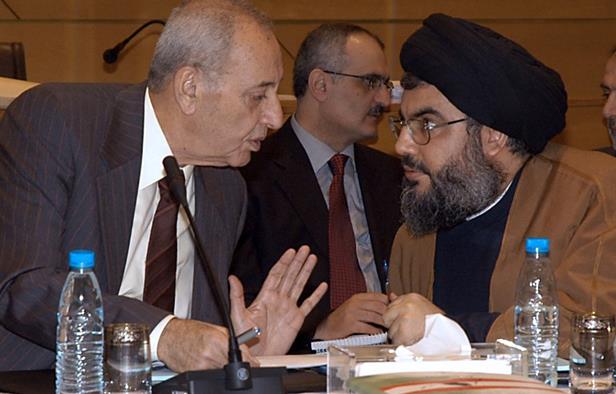The not-so-cold war between Amal and Hezbollah
Myra Abdallah/Now Lebanon/March 11/16
One documentary aired on the pro-Hezbollah Al-Mayadeen television station was enough to reveal the tension and mistrust that exists between Hezbollah and Amal Movement supporters
Last month, Al-Mayadeen began broadcasting a seven-part documentary: “The invasion: Incursion of Lebanon”, documenting Hezbollah’s resistance against the Israeli forces. The program incited a wave of opposition from Amal Movement supporters because, according to them, it was the Amal Movement that founded the resistance and was highly involved in its early operations. However, the documentary attributes all victories to Hezbollah.
This rivalry between the two parties regarding the Shiite community’s legacy is not new. In fact, the relationship between the Amal Movement and Hezbollah always had its ups and downs. Hezbollah was created in 1982 as a guerilla resistance force in reaction to the Israeli invasion of South Lebanon and quickly became the competitor of the Amal Movement – created in 1974 – within the Shiite community on the political level. Ever since, the popular bases of the two major Shiite parties have had more periods of disagreement than agreement. However, in recent decades, notably during the 2005 Cedar Revolution and the 2006 Lebanese-Israeli War, the leadership of the Amal Movement and Hezbollah tried to communicate the same political view, forming a major part of the March 8 coalition. This convergence lasted until Hezbollah decided to intervene in the war in Syria alongside Bashar Al-Assad’s regime whereas Amal Movement refused to officially participate as a combatant force in the conflict. The political plans of the two parties started to gradually diverge afterwards, leading to the most recent disagreement over who should be the Shiite community’s preferred presidential candidate.
“There are many conflicts between Amal Movement and Hezbollah regarding major decisions. In addition to the divergent views on participation in the conflict in Syria, Nabih Berri, for instance, never agreed on [Michel] Aoun as a presidential candidate,” said Annahar analyst Ibrahim Bayram. “Since the beginning, Berri’s view was more moderate and his preferred presidential candidate was Jean Obeid. When [Sleiman] Frangieh was nominated by [Saad] Hariri, Berri supported the nomination and was one of the people who made this arrangement happen, thwarting Aoun’s candidacy.”
Despite continuous efforts from officials in both political parties to ease tensions among their political base, the recent clashes between Nabih Berri and Hezbollah’s General Secretary Hassan Nasrallah had a severe impact on the already unstable relations between their supporters. Residents of Chiyah – an area of Beirut’s southern suburbs controlled by the Amal Movement – told NOW that the situation has become very fragile and dangerous lately, with violent incidents occurring more frequently. “There was an armed clash yesterday between Hezbollah supporters and Amal Movement supporters,” said one Shiyah resident, who lives walking distance from Assad al-Assad Street. “Also last week, we were informed that a Hezbollah supporter shot at an Amal Movement security official at the [party’s] Shiyah office. As a result, the latter ordered the deployment of armed Amal Movement supporters in the area, specifically covering the streets that extend from the internal facade of Mar Mikhael Church towards Moawad Street.”
Other residents whom NOW spoke to said that the clashes started when Hezbollah supporters raised the picture of Nabih Berri during You Stink protests, accusing him of corruption. The situation became more serious after the Burj al-Barajneh double-suicide bombings in November 2015 when Hezbollah replaced Amal Movement’s flags with flags from the Party of God around the site of the explosions.
“The relationship between Hezbollah and Amal Movement can be described as a temporary marriage,” one political analyst who spoke on condition of anonymity told NOW. “The strength of Hezbollah relies on the fact that the party should have no competitors, especially within the Shiite community. However, in order to be powerful, Hezbollah must hold tight to the unity of the Shiite community, therefore it gave a role to Nabih Berri and Amal Movement in the Lebanese political scene. When the adventures of Hezbollah became numerous, especially post intervention in Syria, Berri began attempting to intimidate and blackmail Hezbollah within the Shiite community.”
Amal Movement supporters – who claim precedence as the original Shiite political party and resistance – grew increasingly wary of the influence Hezbollah has gained and its regular attempts to control the Shiite community. Berri’s efforts and the role he plays as head of Lebanese parliament succeeded in easing the tension between his supporters and their Shiite competitors until recently, when clashes between them became too obvious to remain concealed.
“Despite all the efforts to calm people down, the Shiite community is currently divided,” an Amal Movement official told NOW. “Amal’s leadership is really concerned that hatred between Hezbollah supporters and Amal supporters is back.” The Amal official also told NOW that, for the past five years, the party has avoided being in a position of enmity with other political parties. For instance, even though the movement supports the Syrian regime, it made the decision of not fighting alongside Assad’s forces.
“Hezbollah claims they control Lebanon in an attempt to eliminate us. We have a remarkable presence in Beirut. We are in Basta, Khandaq al-Ghamiq, Ain al-Mreisseh, Ramlet al-Bayda, Hamra and Zqaq al-Blat. What do they have? Their project is not controlling Lebanon anymore. Their current project is to hijack the [Shiite] community, but they won’t be able to do it,” he said.




















